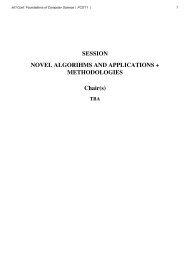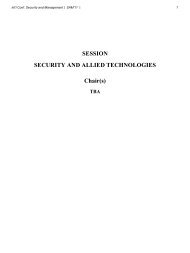Virtual processor frequency emulation - World-comp.org
Virtual processor frequency emulation - World-comp.org
Virtual processor frequency emulation - World-comp.org
You also want an ePaper? Increase the reach of your titles
YUMPU automatically turns print PDFs into web optimized ePapers that Google loves.
performance of guest OS are close-to-native performance.<br />
Paravirtualization is highly adopted and vulgarized by<br />
Xen [8] and VMWare ESX Server [9]. In this context, our<br />
work is based on Xen platform because it is prevalent in many<br />
<strong>comp</strong>uting infrastructures, as well as in the vast majority of<br />
our previous work.<br />
2) Dynamic Voltage and Frequency Scaling (DVFS): Today,<br />
all <strong>processor</strong>s integrate dynamic <strong>frequency</strong>/voltage scaling<br />
to adjust <strong>frequency</strong>/voltage during runtime. The decision to<br />
change the <strong>frequency</strong> is commanded by the current <strong>processor</strong>’s<br />
governor. Each governor has its own strategy to perform<br />
<strong>frequency</strong> scale. According to the configured policy, governor<br />
can decide to scale <strong>processor</strong> speed to a specific <strong>frequency</strong>,<br />
the highest, or the lowest <strong>frequency</strong>.<br />
Several governors are implemented inside the Linux kernel.<br />
Ondemand governor changes <strong>frequency</strong> depending on CPU<br />
utilization. It changes <strong>frequency</strong> from the lowest (whenever<br />
CPU utilization is less than a predefined (low therehold) to<br />
the highest and vice-versa. Performance governor always keeps<br />
the <strong>frequency</strong> at the highest value while slowest CPU speed<br />
is always set by powersave governor. Conservative governor<br />
decreases or increases <strong>frequency</strong> step-by-step through a range<br />
of <strong>frequency</strong> values supported by the hardware. Userspace<br />
governor allows user to manually set <strong>processor</strong> <strong>frequency</strong> [10].<br />
In order to control CPU <strong>frequency</strong>, governors use an underlying<br />
subsystem inside the kernel called cpufreqq [11].<br />
Cpufreq provides a set of modularized interfaces to allow<br />
changing CPU <strong>frequency</strong>. Cpufreq, in turn, relies on CPUspecific<br />
drivers to execute requests from governors.<br />
As aforementioned, effectively usage of DVFS brings the<br />
advantage of reducing power consumption by lowering <strong>processor</strong><br />
<strong>frequency</strong>. Moreover, almost all <strong>comp</strong>uting infrastructures<br />
possess multi-core and high <strong>frequency</strong> <strong>processor</strong>s. Thus, the<br />
benefit from using DVFS has been realized and achieved in<br />
many different systems.<br />
The next section describes the motivation of this work.<br />
B. Motivation<br />
During the last decade, several efforts have been made in<br />
order to find an efficient trade-off between energy consumption/resources<br />
management and applications performance.<br />
Most of them relies on DVFS, and are highly explored due<br />
to the advent of new modern powerful <strong>processor</strong>s integrating<br />
this technology.<br />
According to the ondemand governor (the default governor<br />
policy implemented by DVFS), the CPU <strong>frequency</strong> is<br />
dynamically changed depending on the CPU utilisation. With<br />
this governor, the highest available <strong>processor</strong> <strong>frequency</strong> is set<br />
when the CPU load is greater than a predefined threshold<br />
(up threshold). When the load decreases below the threshold,<br />
the <strong>processor</strong> <strong>frequency</strong> is decreased step by step until the one<br />
capable of satisfying the current process load is found.<br />
However, in most CPUs, the DVFS technology provides a<br />
reduced number of <strong>frequency</strong> levels (in the order of 5) [12].<br />
This configuration might not be enough for some experiments.<br />
Suppose a virtualized muti-core <strong>processor</strong> Intel(R)<br />
Xeon(R) E5520 with 2.261 GHz and the DVFS technology<br />
enable. Consider its six frequencies levels distributed as follows:<br />
1.596 GHz, 1.729 GHz, 1.862 Ghz, 1.995 Ghz, 2.128<br />
GHz and 2.261 GHz. Assume the host OS with a global load<br />
which needs 1.9285 Ghz to be satisfied. Knowing that the<br />
<strong>comp</strong>utation of the best execution time of an application is<br />
made on a basis of the maximum <strong>frequency</strong> of a <strong>processor</strong>,<br />
scheduling it with a lower <strong>frequency</strong> would end up with a<br />
lower than expected performance. From the SLA point of view<br />
and because of the non-existence of the expected <strong>frequency</strong>, the<br />
ondemand governor will set the CPU <strong>frequency</strong> to the first one,<br />
higher that the required <strong>frequency</strong>, capable of satisfying the<br />
current load. Precisely in our example, the ondemand governor<br />
will set the <strong>processor</strong> <strong>frequency</strong> to 1.995 GHz.<br />
However, it would be more beneficial in terms of energy to<br />
assign to the <strong>processor</strong> the exact required <strong>frequency</strong>. Indeed,<br />
the DVFS technology consists of concurrently lowering the<br />
CPU voltage and the CPU <strong>frequency</strong>. By lowering them, the<br />
current total energy consumption of the system is globally decreased<br />
[13]. To improve this well-known energy management,<br />
we will realise some adjustments on the DVFS technology.<br />
Hence, instead of setting the CPU <strong>frequency</strong> to the first higher<br />
available <strong>frequency</strong>, we decided to emulate some of the nonexistent<br />
CPU <strong>frequency</strong> according to the system needs.<br />
Concretely, emulating a CPU <strong>frequency</strong>, in our work, consists<br />
of executing the <strong>processor</strong> successively on the available<br />
frequencies around the desired CPU <strong>frequency</strong>. Our <strong>emulation</strong><br />
process is essentially based on the conventional operation of<br />
the DVFS. The use of the DVFS possesses as asset the fact of<br />
generating no overhead while switching between frequencies<br />
because it has been done in the hardware.<br />
The next section describes our contributions.<br />
III.<br />
CONTRIBUTION<br />
As previously mentioned, the main idea of this paper is<br />
to emulate a CPU <strong>processor</strong> <strong>frequency</strong> based on periodic<br />
oscillations of frequencies between two levels of successive<br />
frequencies. This extension will suggest a way of decreasing<br />
power consumption in virtualized systems while keeping good<br />
VM performance. The next section will expound our approach<br />
and the implementation we made.<br />
A. Our appraoch<br />
Our approach is two folds: (1) To determine the exact<br />
<strong>processor</strong> <strong>frequency</strong> need by the current load and (2) to<br />
emulate it if necessary.<br />
Let’s assume a host with several VMs running on it.<br />
Suppose that they generate a global load of W host . Consider<br />
that we need our CPU to be running at <strong>processor</strong> <strong>frequency</strong> of<br />
f host to satisfy the current load (W host ). However, the desired<br />
<strong>processor</strong> <strong>frequency</strong> f host is not present among the available<br />
<strong>processor</strong> frequencies of our host. This <strong>frequency</strong> need to be<br />
emulated.<br />
A weighted average can be defined as an average in which<br />
each quantity to be averaged is assigned a weight. These<br />
weightings determine the relative importance of each quantity<br />
on the average. Weightings are the equivalent of having that









